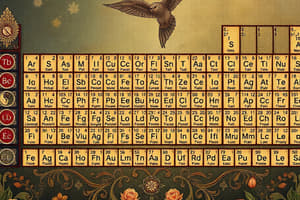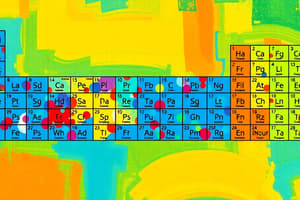Podcast
Questions and Answers
What trend is observed in atomic radius as you move from left to right across a period?
What trend is observed in atomic radius as you move from left to right across a period?
- Atomic radius varies randomly
- Atomic radius decreases (correct)
- Atomic radius remains constant
- Atomic radius increases
Why does the atomic radius increase as you move down a group?
Why does the atomic radius increase as you move down a group?
- Decreased nuclear charge
- Increased number of protons
- Decreased electron shielding
- Addition of electron shells (correct)
Which statement correctly describes the organization of the periodic table?
Which statement correctly describes the organization of the periodic table?
- Elements in the same period have the same number of electron shells (correct)
- Elements are arranged by decreasing atomic number
- Elements in the same group share identical atomic numbers
- Elements in the same column are not related
What primarily causes the decrease in atomic radius from sodium (Na) to chlorine (Cl) within the same period?
What primarily causes the decrease in atomic radius from sodium (Na) to chlorine (Cl) within the same period?
What is the main role of the periodic table according to the content provided?
What is the main role of the periodic table according to the content provided?
How does the atomic radius of elements compare when looking at two elements in the same group?
How does the atomic radius of elements compare when looking at two elements in the same group?
What is the significance of valence electron configurations in understanding periodic trends?
What is the significance of valence electron configurations in understanding periodic trends?
What happens to the atomic radius as you move from a lighter atom to a heavier atom within the same group?
What happens to the atomic radius as you move from a lighter atom to a heavier atom within the same group?
Which atom has a larger atomic radius?
Which atom has a larger atomic radius?
What happens to ionization energy as you move down a group in the periodic table?
What happens to ionization energy as you move down a group in the periodic table?
Which element has a higher electronegativity?
Which element has a higher electronegativity?
Which of the following elements has the highest electron affinity?
Which of the following elements has the highest electron affinity?
How does ionization energy vary across a period?
How does ionization energy vary across a period?
Why does the atomic radius increase down a group?
Why does the atomic radius increase down a group?
Which pair of elements illustrates the trend of decreasing electronegativity down a group?
Which pair of elements illustrates the trend of decreasing electronegativity down a group?
What is the trend in electron affinity as you move across a period?
What is the trend in electron affinity as you move across a period?
Which of the following statements about sodium (Na) and chlorine (Cl) is correct?
Which of the following statements about sodium (Na) and chlorine (Cl) is correct?
Which element is less likely to gain an electron?
Which element is less likely to gain an electron?
What is the effect of additional electron shells on an atom's ability to attract electrons?
What is the effect of additional electron shells on an atom's ability to attract electrons?
In which scenario is an atom most likely to form a cation?
In which scenario is an atom most likely to form a cation?
What trend is observed in the reactivity of alkali metals as you move down the group?
What trend is observed in the reactivity of alkali metals as you move down the group?
The atomic radius of sulfur is smaller than that of oxygen due to the additional electron shell present in sulfur.
The atomic radius of sulfur is smaller than that of oxygen due to the additional electron shell present in sulfur.
Ionization energy decreases as you move down a group due to increased distance between the nucleus and the outermost electron.
Ionization energy decreases as you move down a group due to increased distance between the nucleus and the outermost electron.
Fluorine is less electronegative than chlorine because it is located lower in the periodic table.
Fluorine is less electronegative than chlorine because it is located lower in the periodic table.
Electron affinity generally increases as you move from right to left across a period.
Electron affinity generally increases as you move from right to left across a period.
Chlorine has a lower electron affinity than argon because argon has a complete electron shell.
Chlorine has a lower electron affinity than argon because argon has a complete electron shell.
The atomic radius increases as you move from left to right across a period.
The atomic radius increases as you move from left to right across a period.
Elements in the same group have the same number of electron shells.
Elements in the same group have the same number of electron shells.
Chlorine has a larger atomic radius than sodium because it is further down the periodic table.
Chlorine has a larger atomic radius than sodium because it is further down the periodic table.
As you move down a group in the periodic table, the atomic radius generally decreases.
As you move down a group in the periodic table, the atomic radius generally decreases.
The number of protons in the nucleus affects the atomic radius of an element.
The number of protons in the nucleus affects the atomic radius of an element.
Flashcards are hidden until you start studying
Study Notes
Introduction to Periodic Trends
- The periodic table organizes elements by increasing atomic number, revealing patterns and trends in their properties.
- Key periodic trends include atomic radius, ionization energy, electronegativity, and electron affinity.
- Understanding these trends is essential for predicting element behavior and explaining chemical reactions.
Organization of the Periodic Table
- Elements are grouped into columns (groups) with similar chemical and physical properties due to similar valence electron configurations.
- Elements in the same period (row) share the same number of electron shells.
Atomic Radius
- Defined as the distance from the nucleus to the outermost electron shell, indicating atom size and its interactions.
- Across a Period: Atomic radius decreases from left to right because of increasing nuclear charge, pulling electrons closer. Example: Sodium (Na) vs. Chlorine (Cl).
- Down a Group: Atomic radius increases due to additional electron shells outweighing nuclear charge. Example: Rubidium (Rb) vs. Lithium (Li).
Ionization Energy
- The energy required to remove an electron from a gaseous atom, crucial for understanding how easily an atom forms cations.
- Across a Period: Ionization energy increases from left to right due to rising nuclear charge that creates a stronger attraction for electrons. Example: Neon (Ne) vs. Sodium (Na).
- Down a Group: Ionization energy decreases as increased distance from nucleus due to more electron shells reduces effective nuclear charge. Example: Cesium (Cs) vs. Sodium (Na).
Electronegativity
- Refers to an atom's ability to attract electrons in a chemical bond.
- Across a Period: Electronegativity increases from left to right due to increased nuclear charge. Example: Fluorine (F) is more electronegative than Carbon (C).
- Down a Group: Electronegativity decreases as atomic size increases, making it harder for the nucleus to attract electrons. Example: Fluorine (F) vs. Iodine (I).
Electron Affinity
- The energy change when an atom gains an electron, indicating its tendency to form anions.
- Across a Period: Electron affinity generally increases as atoms become more willing to accept electrons towards a stable octet. Example: Chlorine (Cl) has higher affinity than Sulfur (S).
- Down a Group: Electron affinity decreases because increased atomic size makes gaining an electron less favorable. Example: Fluorine (F) vs. Iodine (I).
Examples to Illustrate Periodic Trends
- Atomic Radius: Sulfur (S) is larger than Oxygen (O) due to an additional electron shell despite both being in the same group.
- Ionization Energy: Chlorine (Cl) has a higher ionization energy than Sodium (Na) due to increased nuclear charge in chlorine.
- Electronegativity: Fluorine (F) is more electronegative than Oxygen (O) due to higher nuclear charge and smaller radius.
- Electron Affinity: Chlorine (Cl) shows higher electron affinity than Argon (Ar) since it is close to achieving a stable octet while Argon has a complete shell.
Applications and Implications of Periodic Trends
- Understanding periodic trends aids in predicting element reactivity in chemical reactions, crucial for safe experimentation and material handling.
- Trends influence material properties such as conductivity, hardness, and melting points; for instance, noble gases exhibit high ionization energy, leading to their inertness.
- Electronegativity impacts biological systems by affecting the structure and function of molecules like proteins and DNA.
- Industrial applications consider periodic trends in the design and use of materials, particularly regarding the reactivity and safe handling of alkali metals.
Summary of Key Periodic Trends
- Periodic trends reveal vital patterns in atomic properties influencing predictions about element behavior and reactions.
- Insights into atomic radius, ionization energy, electronegativity, and electron affinity enhance understanding of chemical interactions and applications in science and industry.
Introduction to Periodic Trends
- The periodic table organizes elements by increasing atomic number, revealing patterns and trends in their properties.
- Key periodic trends include atomic radius, ionization energy, electronegativity, and electron affinity.
- Understanding these trends is essential for predicting element behavior and explaining chemical reactions.
Organization of the Periodic Table
- Elements are grouped into columns (groups) with similar chemical and physical properties due to similar valence electron configurations.
- Elements in the same period (row) share the same number of electron shells.
Atomic Radius
- Defined as the distance from the nucleus to the outermost electron shell, indicating atom size and its interactions.
- Across a Period: Atomic radius decreases from left to right because of increasing nuclear charge, pulling electrons closer. Example: Sodium (Na) vs. Chlorine (Cl).
- Down a Group: Atomic radius increases due to additional electron shells outweighing nuclear charge. Example: Rubidium (Rb) vs. Lithium (Li).
Ionization Energy
- The energy required to remove an electron from a gaseous atom, crucial for understanding how easily an atom forms cations.
- Across a Period: Ionization energy increases from left to right due to rising nuclear charge that creates a stronger attraction for electrons. Example: Neon (Ne) vs. Sodium (Na).
- Down a Group: Ionization energy decreases as increased distance from nucleus due to more electron shells reduces effective nuclear charge. Example: Cesium (Cs) vs. Sodium (Na).
Electronegativity
- Refers to an atom's ability to attract electrons in a chemical bond.
- Across a Period: Electronegativity increases from left to right due to increased nuclear charge. Example: Fluorine (F) is more electronegative than Carbon (C).
- Down a Group: Electronegativity decreases as atomic size increases, making it harder for the nucleus to attract electrons. Example: Fluorine (F) vs. Iodine (I).
Electron Affinity
- The energy change when an atom gains an electron, indicating its tendency to form anions.
- Across a Period: Electron affinity generally increases as atoms become more willing to accept electrons towards a stable octet. Example: Chlorine (Cl) has higher affinity than Sulfur (S).
- Down a Group: Electron affinity decreases because increased atomic size makes gaining an electron less favorable. Example: Fluorine (F) vs. Iodine (I).
Examples to Illustrate Periodic Trends
- Atomic Radius: Sulfur (S) is larger than Oxygen (O) due to an additional electron shell despite both being in the same group.
- Ionization Energy: Chlorine (Cl) has a higher ionization energy than Sodium (Na) due to increased nuclear charge in chlorine.
- Electronegativity: Fluorine (F) is more electronegative than Oxygen (O) due to higher nuclear charge and smaller radius.
- Electron Affinity: Chlorine (Cl) shows higher electron affinity than Argon (Ar) since it is close to achieving a stable octet while Argon has a complete shell.
Applications and Implications of Periodic Trends
- Understanding periodic trends aids in predicting element reactivity in chemical reactions, crucial for safe experimentation and material handling.
- Trends influence material properties such as conductivity, hardness, and melting points; for instance, noble gases exhibit high ionization energy, leading to their inertness.
- Electronegativity impacts biological systems by affecting the structure and function of molecules like proteins and DNA.
- Industrial applications consider periodic trends in the design and use of materials, particularly regarding the reactivity and safe handling of alkali metals.
Summary of Key Periodic Trends
- Periodic trends reveal vital patterns in atomic properties influencing predictions about element behavior and reactions.
- Insights into atomic radius, ionization energy, electronegativity, and electron affinity enhance understanding of chemical interactions and applications in science and industry.
Studying That Suits You
Use AI to generate personalized quizzes and flashcards to suit your learning preferences.




